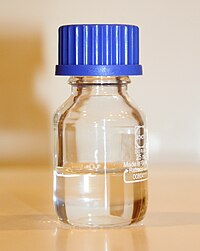
Photo from wikipedia
The development of visible-light photocatalysts for the selective oxidative coupling of amines to imines is an area of great interest. Herein, four hybrid compounds based on polyoxometalate anions and tris(bipyridine)ruthenium… Click to show full abstract
The development of visible-light photocatalysts for the selective oxidative coupling of amines to imines is an area of great interest. Herein, four hybrid compounds based on polyoxometalate anions and tris(bipyridine)ruthenium cations, Ru(bpy)3[M6O19] (M = Mo, W) 1-2, [Ru(bpy)3]2[Mo8O26] 3, [Ru(bpy)3]2[W10O32] 4, are prepared and characterized by X-ray diffraction (single-crystal and powder), elemental analysis, energy-dispersive X-ray spectroscopy (EDS) analysis, infrared (IR) spectroscopy, and solid diffuse reflective spectroscopy. Single-crystal structural analysis indicates that polyoxometalate anions and tris(bipyridine)ruthenium cations interact with each other through extensive hydrogen bonds in these compounds. These hybrid species with strong visible-light-harvesting abilities and suitable photocatalytic energy potentials show excellent photocatalytic activity and selectivity for the oxidation of amines to imines at room temperature in air as an oxidant. Among them, compound 1 with the [Mo6O19]2- anion has the highest catalytic activity, which can swiftly convert >99.0% of benzylamine into N-benzylidenebenzylamine with a selectivity of 98.0% in 25 min illumination by a 10 W 445 nm light-emitting diode (LED). Its turnover frequency reaches 392 h-1, which is not only better than the homogeneous catalyst [Ru(bpy)3]Cl2 but also much superior to those achieved over most of reported heterogeneous catalysts. Moreover, it shows a wide generality for various aromatic amines, accompanied by the advantages of good recyclability and stability. The photocatalytic oxidation mechanism of amines to the corresponding imines over polyoxometalate-based hybrid compounds was fully investigated.
Journal Title: Inorganic chemistry
Year Published: 2022
Link to full text (if available)
Share on Social Media: Sign Up to like & get
recommendations!